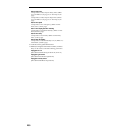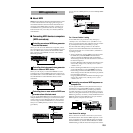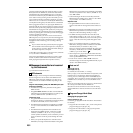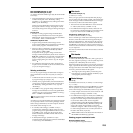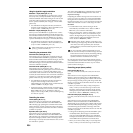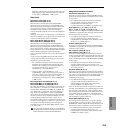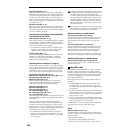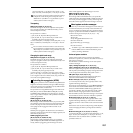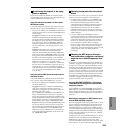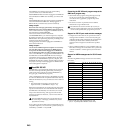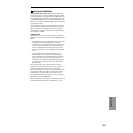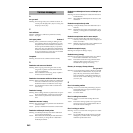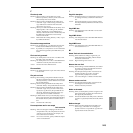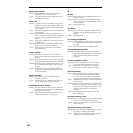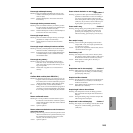
238
Master coarse tuning [F0, 7F, nn, 04, 04, vv, mm, F7]
(Normally only the upper byte mm is used. A value of 8192
[mm, vv=40, 00] is center, 6656 [mm, vv=34, 00] is –12 semi-
tones, and 9728 [mm, vv=4C, 00] is +12 semitones.)
When this is received, “Key Transpose” (GLOBAL 1.1–1a)
parameter will be set.
Transmitting sound settings data (Data Dump)
Data for programs, combinations, drum kits, user arpeggio
patterns, global settings, and sequencer data can be trans-
mitted as MIDI exclusive messages. The operation of send-
ing this system exclusive data to an external device is called
a “data dump.”
By performing a data dump, you can store the TRITON Le’s
sounds and settings on an external device, or rewrite the
sounds and settings of another Future instrument.
There are the following three types of data dump.
•When you use the utility manu command “Dump”
(GLOBAL 2.1–1c) to dump data, various types of
internal memory data will be transmitted. If this data is
received by the TRITON Le, the data will be written
directly into internal memory, and it will not be
necessary to perform the Write operation. (☞p.129, 130
“Transmission,” “Reception”)
• If “Exclusive” (GLOBAL 2.1–1b) setting is checked,
selecting a combination in COMBI 1.1: Play will transmit
data for one combination. Selecting a program in PROG
1.1: Play will transmit data for one program.
This data is the edit buffer data for the currently selected
combination or program. If this data is received by the
TRITON Le, the data will be written into the edit buffer,
so if you wish to save it to internal memory, you will
need to perform the Write operation. The Write operation
can also be performed by a MIDI exclusive Program
Write Request or Combination Write Request message, in
addition to the usual method of using the TRITON Le’s
switches. (☞BG p.41 “Saving data”)
• If “Exclusive” (GLOBAL 2.1–1b) setting is checked, data
will also be dumped in response to a Dump Request
message. This data is transmitted and received on the
global MIDI channel.
Editing sounds etc.
By using various MIDI exclusive data dumps, you can
rewrite all programs or an individual program. By using
parameter change messages, you can edit individual param-
eters as follows.
Parameter changes
• In Program mode, all parameters other than the program
name can be edited. Performance editor parameters are
included.
• In Combination mode, parameters other than the
combination name can be edited.
Drum kit parameter change/User arpeggio pattern
parameter change
• In Global mode, you can edit drum kits and user
arpeggio patterns.
Since the other global parameters or Sequencer mode data
cannot be edited, you will use data dumps to transfer this
data. Data dumping of Sampling mode data is not sup-
ported.
The global MIDI channel is used to transmit and receive this
data.
First check “Enable Exclusive” (GLOBAL 2.1–1b), so that
exclusive data can be transmitted and received. When you
change modes on the TRITON Le, a mode change message
will transmitted. When you change programs or combina-
tions, the parameters for one program or one combination
will be transmitted together with the program change.
When you edit individual parameters, parameter change,
drum kit parameter change, or user arpeggio pattern param-
eter change messages will be transmitted.
When these messages are received, the same editing opera-
tion will be performed as on the transmitted device.
After MIDI exclusive data has been received and processed,
a Data Load Completed message will be transmitted. The
control master device must not transmit the next message
until this message is received (or until a sufficient interval of
time has elapsed).
When you change programs or combinations, or use param-
eter changes to edit, the changes will affect the data in the
edit buffer and will not be stored in internal memory unless
you Write, so that the changes will be lost if you re-select the
program or combination. The Write operation can be per-
formed by a MIDI exclusive Program Write Request or Com-
bination Write Request message, in addition to the usual
method of using this instrument’s switches. (☞BG p.41
“Saving data”)
It is not necessary to write a song, but it will not be backed
up when the power is turned off. If you wish to keep the
data, save it on external media before turning off the power.
(☞BG p.45 “Saving on external media”)
If notes are “stuck”
If for some reason, notes become “stuck” and will not stop
sounding, you can usually stop the sound by changing the
mode. If notes played via MIDI are stuck, you can discon-
nect the MIDI cable.
MIDI transmits a message called Active Sensing [FE] at reg-
ular intervals. A device that receives this message will be
aware that an external MIDI device is transmitting to it. Sub-
sequently, if no MIDI messages are received for a certain
interval of time, the receiving device will decide that the
connection has been broken, and will turn off any notes that
had been sounded via MIDI and reset its controller values.
Playing the TRITON Le multi-timbrally from
an external device
The TRITON Le can be connected to an external device and
played multi-timbrally in the following ways.
•MIDI messages from the external device can play a
combination (8-part multi-timbral performance). You
can change the overall settings (programs, levels, and
effects) by using program change messages to switch
combinations.
•MIDI messages from the external device can be used to
play a song (16-part multi-timbral performance). Overall
settings (programs, levels, effects etc.) can be changed by
using a Song Select message to switch songs. (Song
Select messages can be received if “MIDI Clock”:
GLOBAL 2.1–1a is set to External.)
•MIDI Clock messages from the external device can be
used to make the TRITON Le playback a song (set
“MIDI Clock” to External, and run this instrument’s
sequencer). You can change the overall settings
(programs, levels, effects) by using song select messages
to switch songs.



